by Wine Owners
Posted on 2021-08-18
By Miles Davis
From time to time in the past, wine merchants and market observers have pointed to the Northern Rhone and proclaimed that its time has come, it is arriving, it is time to load up – this is with the view to making a few quid, of course. Always lagging the more powerful Bordeaux and Burgundy regions, I think this extraordinary piece of France where Syrah flourishes on the steep riverside slopes, has always been considered to be of a slightly lower, more rustic class. Certainly us Brits tend to be educated in the ways of Bordeaux first and foremost, then Burgundy, and then the likes the Rhone, Champagne, Tuscany and Piedmont etc. follow along in no particular order. As Bordeaux, then Burgundy prices headed skywards, people noticed, from time to time, that the Rhone was being left behind. Surely the clever money should have some of that? It has never quite happened. Sure, some producers have developed close followings from astute collectors and the likes of Jean Louis Chave, Jamet, Auguste Clape and Thierry Allemand to name a few have all seen demand for their wines shoot up and secondary market prices have reacted accordingly. But a lot of the bigger names, the biggest being Chapoutier, Guigal and Jaboulet just have not done very much price wise.
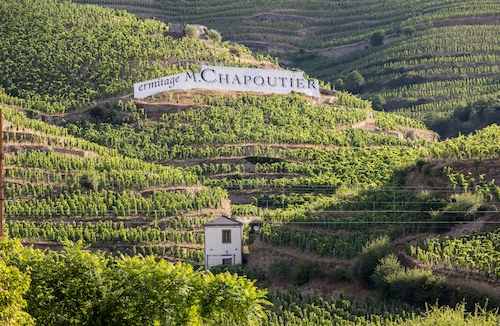
Randomly selected, I compared three vintages of La Landonne from the Côte Rôtie Guigal powerhouse, ’90, ‘05 and ’10, over the last five years and price increases have been +14%, +27% and +14% respectively. These numbers do not include any trading and logistic costs, and in the context of a decent wine market, are disappointing.
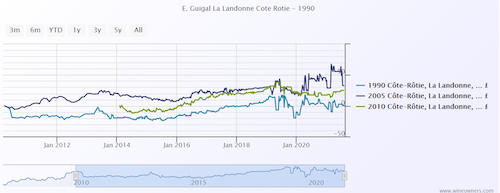
So, the question is, is this all about to change? Liv-ex recently reported their Rhone 100 sub-index is the second-best performing sub index (which covers both Northern and Southern Rhone) in their stable, trailing only Champagne, over the last eighteen months. That is quite some achievement and not to be overlooked. I have been commenting for some time how the wine market is broadening, ‘lesser’ regions becoming more liquid in the secondary market, making them more tradeable and easier to value – all important factors when considering investment. There’s no question there are a lot of critic’s points available for relatively little money and ironically, this most historic of regions offers the cheapest entry point into the ‘fine wine’ market. So, I do believe this is changing and I would certainly recommend having some Northern Rhone in a portfolio or collection. For investment purposes I would not risk really big ticket items such as Guigal’s La Las or even Jean-Louis Chave’s Hermitage as they are already relatively expensive and until we are fully convinced these are really investable items and/or Asia takes to the area more than in the past.
For immediate consumption purposes I have had multiple buying successes on the Wine Owners platform in recent times, snapping up Chapoutier’s Hermitage Sizeranne from ’96 and ’99 for £30-33 per bottle (before tax), Côte Rôties from Gilles Barge (very fair value) from ’00 and ‘05, René Rostaing (prices have been moving), Clusel Roch (good value) and La Petite Chapelle from Jaboulet, all of which have given great pleasure.
And finally, you may have read this here before (!!), I think Hermitage La Chapelle from Paul Jaboulet Ainé (to give the full name) is one of the best bets around right now, and there are plenty of vintages to choose from, from 2009 onwards! Ship it in!
Here are some relative value scores for some very high scoring La Chapelles. Remember you never see a first growth Bordeaux or a grand cru Burgundy in double figures, let alone in the 20s.
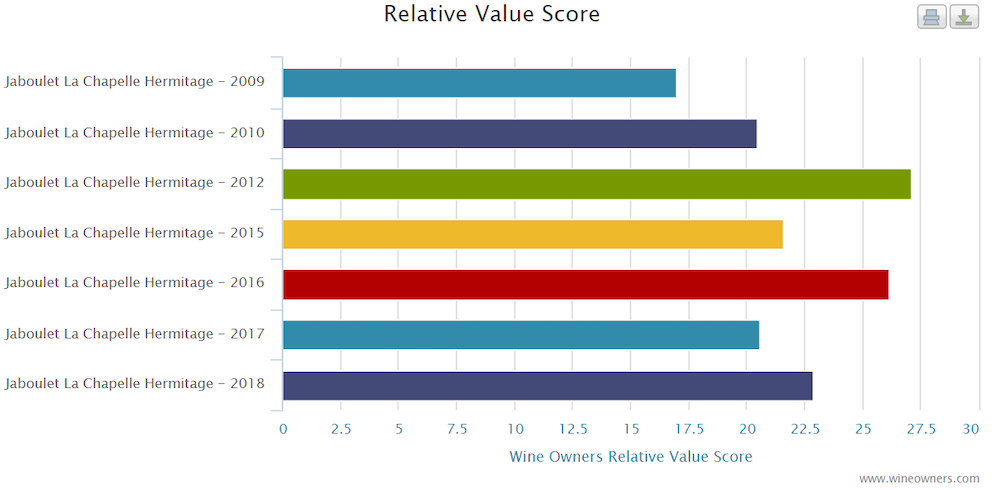
Some of the most notable names to remember:
Hermitage: Chapoutier, Chave, Delas, Jaboulet
Cote Rotie: Chapoutier, Guigal, Jamet, Jasmin, Rostaing
Cornas: Allemand, Clape
St. Joseph: Chave
by Wine Owners
Posted on 2021-08-12
Did you know that when you use Wine Owners to track and manage your wine collection, you have the option to add your own tasting notes and scores when consuming a wine?
You have the option to anonymously share these notes with the wider community, or keep them private for your own future reference, adding drink dates or scores as you see fit (and according to your own personal preferences!)
When you come back at a later date to revisit said wine, your notes will appear alongside those of your linked critic accounts giving you the fullest picture possible!
If you have accounts with Vinous, Jancis Robinson or Robert Parker, you can link these to your Wine Owners account and view their reviews on WO for everything. A free Robert Parker subscription is included when you take out Wine Owners premium plan (along with lower selling fees and a host of other benefits) so even more reason to upgrade your account.
You can view your entire catalogue of tasting notes via the “My Tasting Notes” option under the “Manage” drop down menu, or view notes individually under the “reviews & scores” tab within a wine entry (see below)
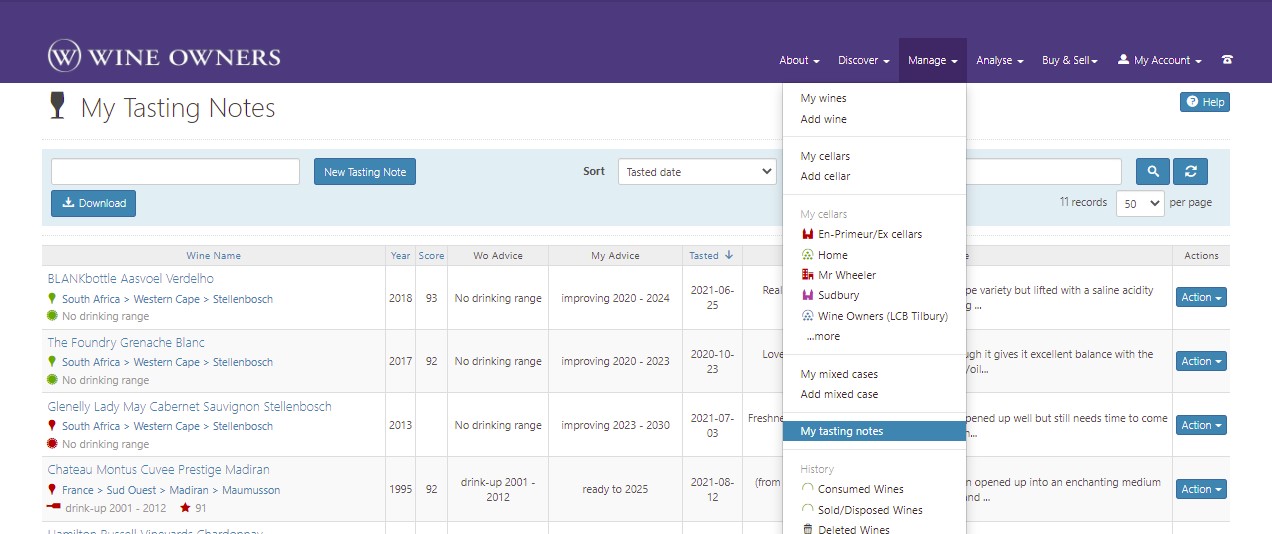
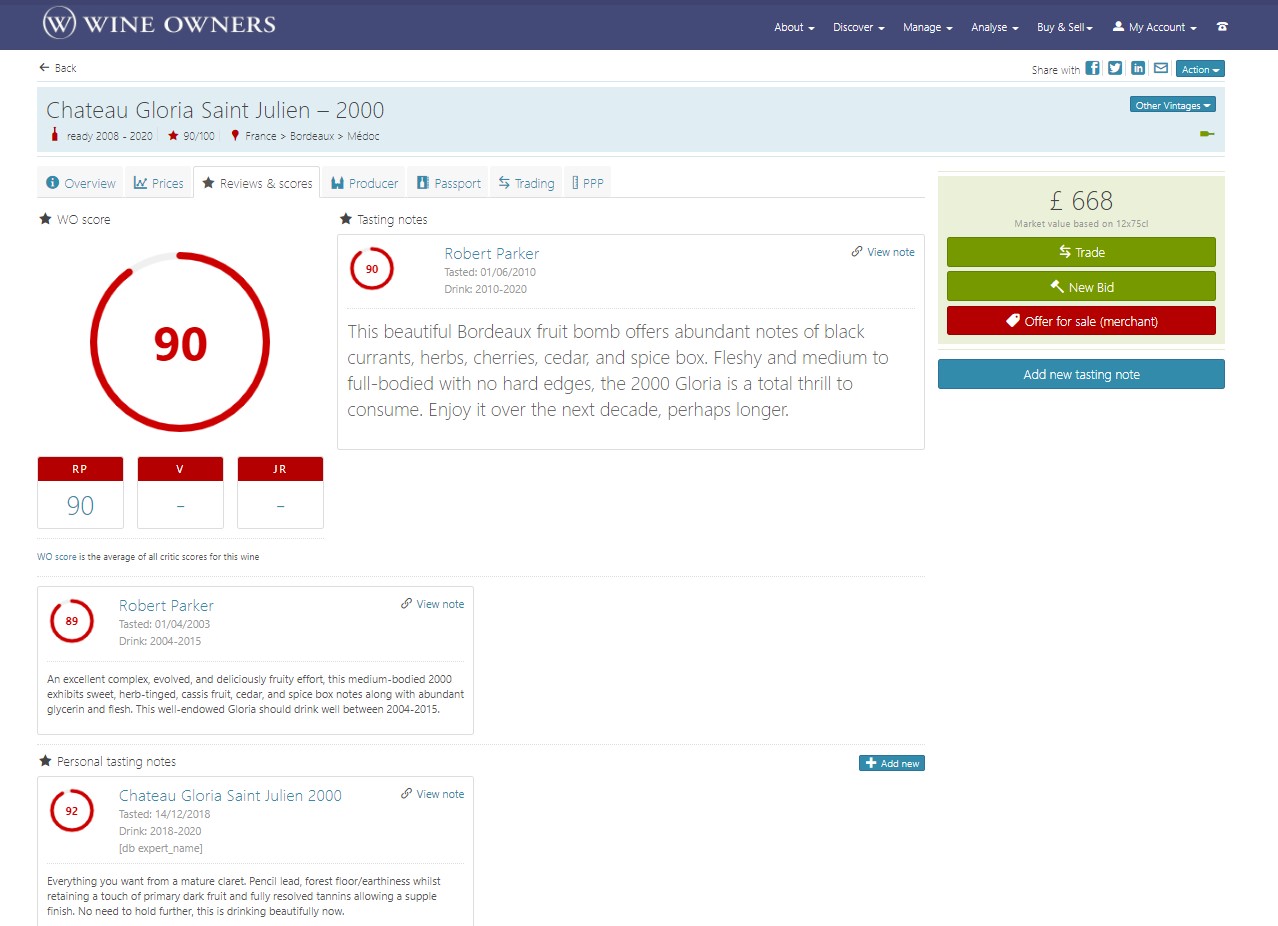
by Wine Owners
Posted on 2021-08-06
The problems with white Burgundy in the past have been well documented; namely premature oxidisation, or premox for short. In a former job spec, managing FCA grade wine investment funds, the problems were enough for us to have one simple discipline when it came to white Burgundy – do not invest. Although I have seen thousands of pounds worth of Grand Crus literally poured down the sink from vintages past, these problems are behind us now and there is more belief in this area than possibly ever before. The grandest Crus stand head and shoulders above their peers in much the same way as their red counterparts do, and they always will. After all, they have been growing grapes in them there hills since 150 B.C. according to Neal Martin’s excellent recent piece for Vinous Media, so they know a thing or two about the land and how to achieve the best results.
Again, like the reds, the vineyard areas are small, so production levels are low. There are less than half the number of white Grand Crus compared to red however, and the famed village of Meursault is not even deemed worthy of having a single one! There are two that do both, namely Corton and Musigny. The very top producers have been sold by allocation only for some time now, but are still behind the reds in that regard, and on average price too. Buyers should not only look at Grand Crus as there are many superb Premier Crus too that can deliver – even some in lowly Meursault! Also, it is not necessary just to stick to names with ‘Montrachet’ in them, there are some viable options from other villages and Chablis of course. The Côtes of Maconnais and Chalonnaise are not made of quite enough stuffing to qualify for ‘investment grade’ but there’s no doubting the quality of these wines continues to rise.
White Burgundies tend to disappear off the market after a few years of age as global demand far outstrips supply. This makes valuations and therefore performance numbers hard to measure accurately so you’ll just have to believe me that they really can perform. Here’s one example of a young wine since release (c.50% annualised ROI!):
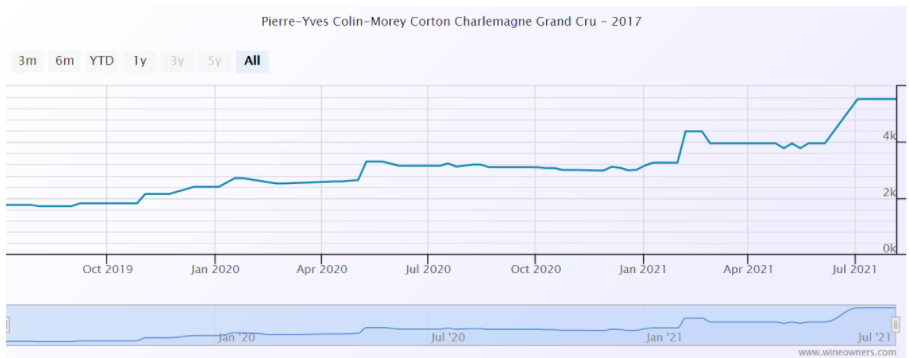
I happen to think that this wine has not stopped motoring yet, and there are only but a couple of cases (six packs) currently on the market. Why do I say this? Because prices for white Burgundies are still a fraction of their equivalent red counterparts, there is less of it, and there is vast burgeoning demand, and it is global. There is also the threat that global warming may mean there’s even less of this stuff to go around in the future, and perhaps not as well balanced, classical and chiselled as we are used to.
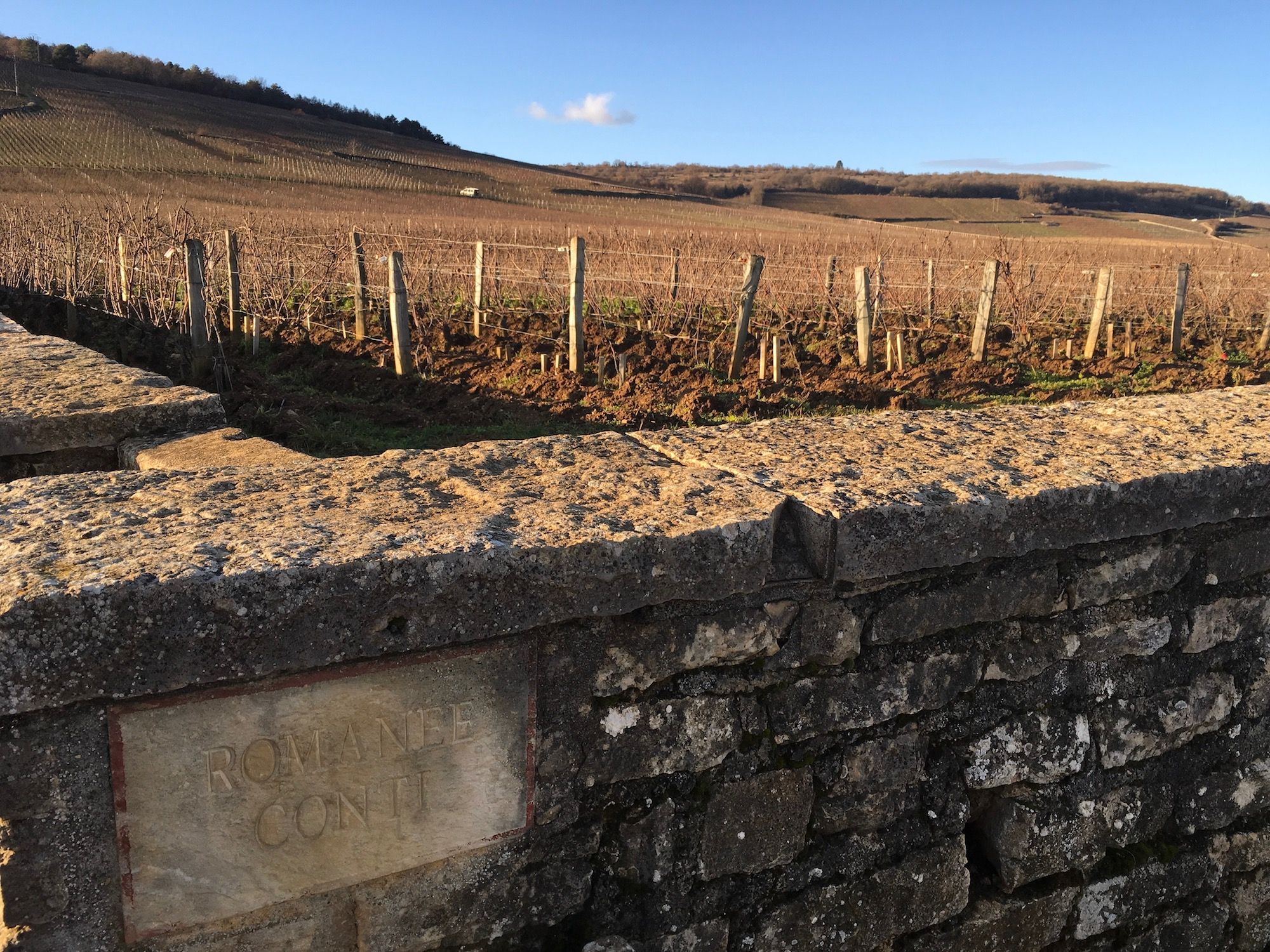
As a rough guide, village wines should probably be drunk between three and ten years of their life, Premier Crus five to fifteen and Grand Crus ten years plus, they can last for decades. My advice would be, if you are buying into this rationale, is to invest primarily in good producers, most Grand Crus (if they haven’t already tripled!), and then in highly rated premier crus (particularly from the ’14 and ’17 vintages). Obviously, the vineyards are important too and the ‘jewel in the crown’ sites of producers can often produce an extra bit of uplift.
Some of the names to look out for, amongst others:
- Boillot, Henri
- Bonneau du Martray
- Coche Dury (‘silly money’!)
- Comtes Lafon
-
Dauvissat
DRC (‘silly money’!)
-
Leflaive
- Moreau, Bernard
- Pierre-Yves Colin-Morey
-
Ramonet
- Raveneau
-
Roulot

